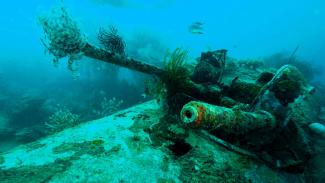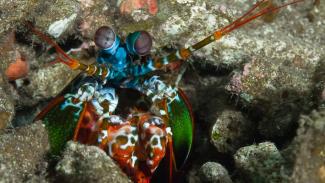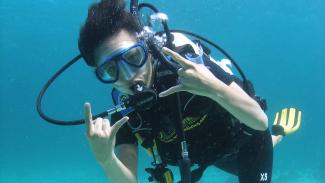Discover the best liveaboard diving in Southeast Asia
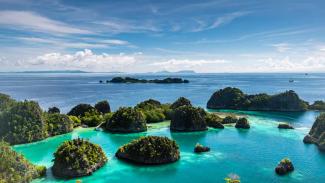
Surita Budiman
The countless islands and complex geography of Southeast Asia have given rise to many remote regions, and some of the best liveaboard diving in the world.
All over the region, there are world-class liveaboard boats offering itineraries to some truly magical destinations.
In our Guide to Asia's top Liveaboards, we take a journey together around the very best liveaboard itineraries in Asia with detailed information, top tips and how to book your perfect liveaboard adventure...
Looking for the latest liveaboard deals? Find your deal

Go back a few years, and the majority of diving was done from resorts, making day trips with a local dive center. Nowadays, liveaboards are a hugely popular option for scuba divers. But what is liveaboard diving? What are the pros and cons, and is it for you?
Liveaboard diving is essentially a small cruise for scuba divers, spending a number of nights diving from a liveaboard boat. You sleep, eat, dive, make friends and have fun on board. They typically take between 12 and 30 divers at a time and are able to explore some of the very best diving regions in the world.
Pros and cons of liveaboard diving
Liveaboard diving has become massively popular, but it is not necessarily for everyone. There are pros and cons. One of the key advantages to liveaboard diving is their ability to take divers to the most remote and spectacular dive destinations, reaching areas that are often far beyond the reach of day dive boats. This mobility also means that you’ll get to see a much larger area and experience a wider range of dive sites. As the entire focus is diving, liveaboard boats tend to include lots of dives also, generally (but not always) three or more a day. For those looking for friendship and fun, they also offer excellent camaraderie. Finally, while liveaboards can be expensive, they still represent great value for money given the experience, destinations visited and amount of diving included.
What about the disadvantages? Well, liveaboards tend to favour more experienced divers and tend to be quite intense. They suit divers that are looking to do as much diving as possible. Unless you are travelling with a friend or partner, or willing to pay a hefty single supplement, they will also likely mean sharing a cabin with a stranger. That is fine for some, but of course not appealing to others.
All in all though, liveaboard boats have become immensely popular for good reasons, offering world-class diving experiences to serious divers.
Liveaboard vs resort
Which is best for you? That depends in part on what you are looking for from your trip. Resort-based diving holidays allow you to pick and choose your experiences a little more and mix diving with other activities, or simply relaxing on a beach and watching the world go by with a refreshing drink. Depending on the set-up, you can enjoy some dives in the morning and take the afternoon to enjoy other pursuits. Resorts also bring greater space and freedom, plus a choice of restaurants and eating options. If you tend to get seasick, a resort-based diving adventure is possibly more suited to you.
Liveaboard diving, on the other hand, usually offers the highest quality diving experiences available and allows you to maximise the diving you can do in any given period, taking you to the very best dive sites at the same time. For the right person, they are simply the best way to dive.
Liveaboard diving in Asia
Asia is blessed with a multitude of superb liveaboard diving options. With over 17,000 islands, Indonesia has some of the best liveaboard diving in the world. Mesmerising liveaboard experiences can also be enjoyed in the Philippines, Thailand, Myanmar and Papua New Guinea. We recommend arranging your liveaboard adventure with the crew at liveaboard.com, and you'll find some links throughout this article. We can make earnings from these links, which helps to fund the website.
So without further ado, let’s dive in to some of the most incredible liveaboard adventures in Asia…

Tara North
Starting from Phuket or Khao Lak in Thailand, this classic liveaboard journey first takes you to the beautiful Similan Islands, then north to some more of Thailand's top dive sites. It makes for a great introduction to liveaboard diving as itineraries tend to be shorter than some other destinations.
Similan & Surin Island liveaboard itineraries start from as little as 3 days in duration. These shorter itineraries tend to focus on either the Similan or Surin Islands rather than both due to the shorter time available. Many liveaboards offer itineraries of 4-6 days in length, with longer options also available. The more adventurous may wish to take a longer liveaboard cruise that travels north into Myanmar as well.
Highlights include the famous dive sites of the Similans such as Elephant Head Rock, East of Eden & Christmas Point. To the north of the Similan Islands, Koh Bon is renowned for Manta Ray sightings, while Richelieu Rock offers magical marine life and the chance of a Whale Shark encounter. These more northern dive sites are often referred to as the Surin Islands.
Search for your Thailand liveaboard
Similans Liveaboard Snapshot
- When to go: November through to April
- Duration: 3 days to 7 days
- Embarkation Point(s): Tap Lamu Pier (Khao Lak) or Chalong (Phuket)
- Prices guide: Similans liveaboards start from around US$100 per day, with many options around $140 to $180 per day.
- Marine life highlights: Manta Rays, Whale Sharks, Leopard Sharks, Turtles, Smaller marine life.
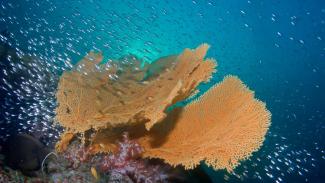

Farjuddin Mudzakkir
Raja Ampat liveaboard diving almost needs no introduction. Raja Ampat is a large area at the very center of the Coral Triangle, and perfectly suited to liveaboard diving. It offers arguably Southeast Asia's best liveaboard diving, and arguably the best coral reef diving in the world.
Divers can expect to be wowed by the most diverse, impressive coral reefs on earth, and encounters as varied as Manta Rays, Epaulette Sharks and Pygmy Seahorses. For many, Raja Ampat has it all!
Liveaboards tend to depart from Sorong and embark on adventures lasting between 8 and 12 days in duration. Raja Ampat covers a vast area and shorter itineraries tend to focus on either the northern or southern areas. Longer itineraries often tour the entire region.
While the scuba diving in Raja Ampat is not especially challenging, the area is remote and rather difficult to reach, which tends to suit divers with more experience.
Search for your Raja Ampat liveaboard
Raja Ampat Liveaboard Snapshot
- When to go: November through to April
- Duration: 8 to 12 days, with occasional longer itineraries
- Embarkation Point(s): Sorong, with occasional departures from Wewak
- Price guide: Raja Ampat liveaboards prices start from around US$270 per day, with luxury options up to $500 per day or more.
- Marine life highlights: With the highest biodiversity on earth, expect to see everything from Sharks and Manta Rays to tiny Pygmy Sea Horses, and everything in between.
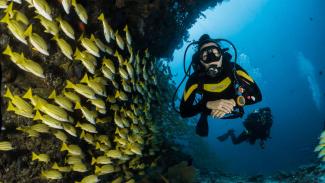
Sebastian Pena Lembarri

The Philippines' top liveaboard adventure takes you to the heart of the Sulu Sea, where two large atolls known as the Tubbataha Reefs rise up from abyssal depths to the surface. Tubbataha rewards divers who make it this far with a superb show of big marine life, including huge schools of swirling Barracuda, heaps of Turtles, big Mantas and plenty of species of Shark. The adventure also takes in other equally spectacular atolls nearby.
Tubbataha liveaboards are generally 7 or 8 days in duration, departing from and returning to Puerto Princessa on the island of Palawan. There is an overnight crossing to get to the dive sites, which are all located in the center of the Sulu Sea. This crossing means Tubbataha can only be dived in a short window from March to early June when the crossing is possible.
Expect kaleidoscopic reef life, superb wall diving and plentiful pelagic species to enjoy. Later in the Tubbataha season, Whale Sharks can also be seen here.
Search for your Tubbataha liveaboard
Tubbataha Liveaboard Snapshot
- When to go: March through to early June
- Duration: 7 or 8 days
- Embarkation Point(s): Puerto Princessa
- Price guide: Tubbataha liveaboards prices start from around US$150 per day, with the majoroty of liveaboards offering itineraries between $250 and $350 per day.
- Marine life highlights: Grey Reef Shark, Hammerhead Shark, Manta Ray, Green Turtle, Whale Shark
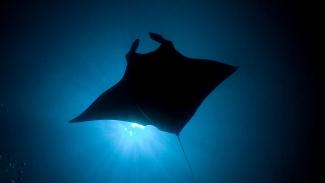
Tara North
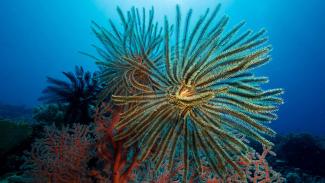
The central group of islands that make up the Philippines is known as the Visayas. It is home to some of the best diving in the Philippines. While all areas can be visited individually from resort-based diving centers, exploring the area by liveaboard takes in the superb macro diving of Dauin, the whale sharks of Oslob, the coral reefs of Moalboal, Apo Island and Bohol all in one trip. Some itineraries also head north to include Malapascua and her famous Thresher Sharks too.
Liveaboards generally depart from Cebu, with some options departing Dumaguete. Liveaboard trip lengths range from 7 days up to 13 days, depending on the itineraries. Shorter itineraries tend to be a little more common, and kind be combined with time in resort.
The big draw of liveaboards to the Visayas are the variety of diving and experiences that can be had in a relatively short trip. Visayas itineraries are available throughout the year with hte exception of March to June, when most liveaboards head to Tubbataha.
Search for your Visayas liveaboard
Visayas Liveaboard Snapshot
- When to go: June to February.
- Duration: 7 to 13 days
- Embarkation Point(s): Cebu, or occasionally Dumaguete
- Prices from: Visayas liveaboards prices start from around US$150 per day, with the majority of liveaboards offering itineraries between $250 and $350 per day.
- Marine life highlights: Excellent corals, macro life, Whale Sharks, Turtles.

Sebastian Pena Lambarri
You might also enjoy...
Wreck diving hotspots
With so much coastline and so many seas, it is no wonder that South-east Asia has some of the best wreck diving in the world.
Many of the region's wrecks are not only great for their level of preservation & fascinating history, but also for the amount of marine life that now calls them home.
So if you want to experience some world-class wreck diving, click on a hotspot below...
Muck diving meccas
If you are an avid underwater photographer or a lover of the weird and wonderful, then the seas of Asia hold a treasure trove of delights.
Originally pioneered in Papua New Guinea, muck-diving is now all the rage, and incredibly addictive. As the epicentre of the world's marine biodiversity, there are exceptional opportunities throughout South-east Asia.
Underwater photography hotspots
Asia is blessed with all the ingredients any budding underwater photographer could ever wish for.
It has an enormous variety of dive sites, incredible diversity, an almost limitless choice of subjects and many highly professional dive centres to choose from.
But where are some of the very best spots for underwater photography & video? Our quick guide gives you the lowdown...
Best places for beginner divers
Asia has a huge number of dive spots that have perfect conditions for learning to dive. It has so many in fact, that you may be having a hard time choosing where you should go.
Scuba diving in Borneo - 7 key questions answered
Tara North


